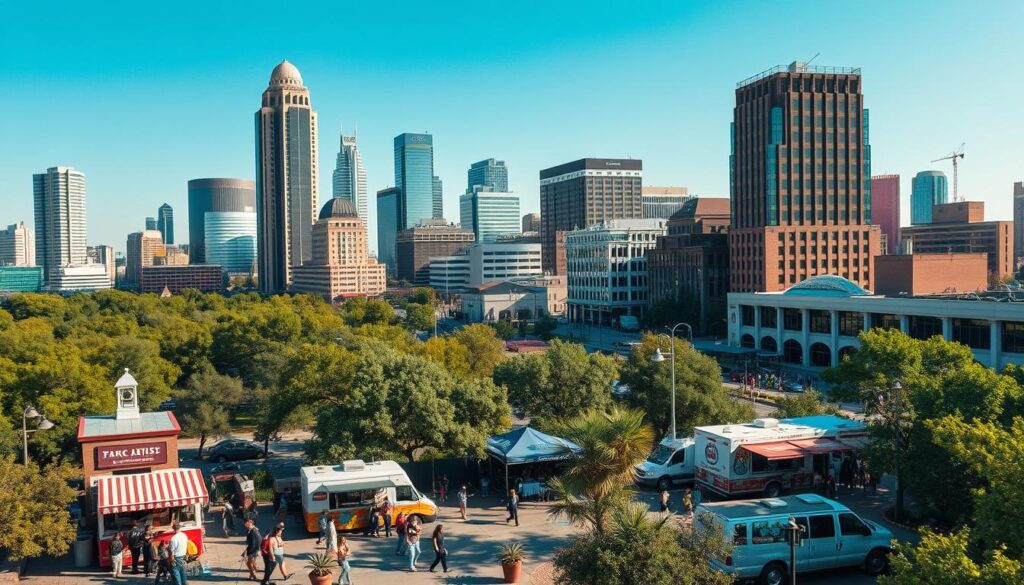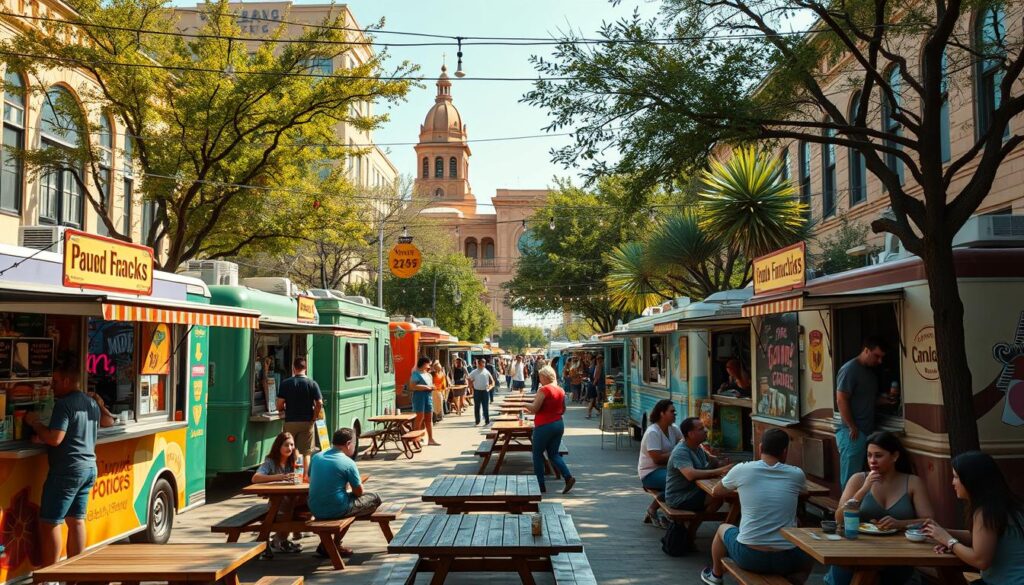Is Moving to Austin Worth It?
Get Your Free Moving Estimate
As we embark on the journey to answer the question, “Is moving to Austin worth it?”, we recognize the significance of this decision for many prospective residents. Austin stands out as a vibrant city celebrated for its unique culture, robust job market, and diverse lifestyle options. In this comprehensive overview, we will explore critical aspects of life in Austin, providing Austin relocation advice to help you assess whether this dynamic city aligns with your personal and professional aspirations.
Key Takeaways
- Austin boasts a rich cultural scene and a thriving economy.
- Consider the varied lifestyle options available when relocating.
- Evaluate job opportunities and employment sectors in the area.
- Review cost of living factors before committing to a move.
- Understand the city’s community dynamics and social landscape.
1. Overview of Austin: A Quick Introduction
Austin, the capital of Texas, stands out for its vibrant blend of modernity and tradition. Known for its music scene, tech industry, and outdoor activities, the city provides a unique quality of life. As we explore Austin’s key features, cultural significance, and remarkable population growth trends, one can see why it’s becoming a popular destination for newcomers.
Key Features of Austin
Austin is renowned for its eclectic atmosphere and diverse population. Some key features include:
- Exceptional music venues and festivals, often dubbed the “Live Music Capital of the World.”
- A thriving tech sector, with numerous startups and established companies.
- Beautiful parks and lakes, promoting outdoor recreational activities.
Cultural Significance
The cultural significance of Austin is evident in its rich history and artistic endeavors. The city fosters creativity through:
- Annual events like South by Southwest (SXSW) and the Austin City Limits Music Festival.
- A myriad of art galleries and theaters contributing to the local arts scene.
- Culinary diversity, showcasing local flavors through food trucks and restaurants.
Population Growth Trends
Population growth in Austin has surged over the years, making it one of the fastest-growing cities in the United States. Notable trends include:
- An influx of young professionals seeking opportunities in technology and creative sectors.
- Families moving to the area in search of a high quality of life and educational resources.
- Rising demand for housing, which influences Austin living expenses.
2. Cost of Living in Austin
Understanding the cost of living in Austin involves delving into various financial components such as housing, daily expenses, and taxes. We will assess each element to give a clear picture of what potential residents can expect when relocating to this vibrant city.
Housing Market Analysis
The Austin housing market analysis reveals significant trends. Home prices have seen a steady increase over the past few years. Factors influencing this growth include:
- Demand for housing driven by population growth
- Proximity to major employers and tech hubs
- Limited inventory leading to competitive bidding
As a result, average home prices currently hover around $500,000 with rental prices averaging $2,200 for a two-bedroom apartment. Understanding these dynamics is essential for anyone considering a move.
Daily Expenses Comparison
Assessing daily expenses in Austin highlights both affordability and areas where costs can accumulate. Key components include:
| Expense Category | Average Monthly Cost |
|---|---|
| Groceries | $400 |
| Transportation | $120 |
| Health Insurance | $300 |
| Dining Out | $250 |
These figures provide a baseline for understanding how daily expenses in Austin may compare to other urban centers.
Taxes and Utility Costs
When relocating, it is crucial to consider both taxes and utility costs. Texas does not impose a state income tax, which can be financially advantageous. On the flip side, property taxes can be higher, averaging around 2.06%. Utility costs typically total approximately $180 per month, covering essentials such as electricity, heating, and water. This balance of taxes and utility costs impacts the overall cost of living in Austin and should be part of any budgeting plan for newcomers.
3. Job Opportunities and Employment Sectors
Austin stands out as a dynamic hub for job seekers, driven by a flourishing economy and a variety of employment options. The region attracts professionals from different backgrounds, thanks to the city’s booming sectors and major employers. We will delve into the thriving industries in Austin, explore the influential companies, and highlight the rise of remote work and freelancing here.
Thriving Industries in Austin
The robust job market is supported by several thriving industries. Key sectors attracting talent include:
- Technology – Austin has established itself as a tech hotspot, often referred to as “Silicon Hills,” with numerous startups and established firms driving innovation.
- Healthcare – An expanding healthcare sector provides a wealth of job opportunities, with healthcare providers and research institutions leading the charge.
- Education – With renowned universities and colleges, the education industry continues to grow, creating various employment avenues.
- Creative Services – The arts, media, and design sectors thrive in Austin, contributing lively cultural and economic activity.
Major Employers and Startups
Job opportunities in Austin flourish through a mix of established employers and emerging startups. Some of the notable major employers include:
| Employer | Industry | Employees |
|---|---|---|
| Dell Technologies | Technology | Over 14,000 |
| University of Texas at Austin | Education | Over 23,000 |
| St. David’s Healthcare | Healthcare | About 9,000 |
| IBM | Technology | Approx. 5,000 |
| Whole Foods Market | Retail | Over 2,000 |
Remote Work and Freelancing
In recent years, there has been a significant rise in remote work and freelancing opportunities in Austin. Many companies now offer flexible work arrangements. This shift expands the job landscape, allowing professionals to work for major employers in Austin while enjoying the city’s vibrant lifestyle. Freelancing platforms are also gaining traction, enabling individuals to connect with clients worldwide and offer their services from the comfort of their homes.
4. Quality of Life in Austin
When considering the quality of life in Austin, we find a blend of outstanding health and wellness facilities, strong educational systems, and a plethora of outdoor activities. Each aspect contributes significantly to how residents experience life in this vibrant city.
Health and Wellness Facilities
Austin prides itself on its extensive health and wellness offerings. Numerous hospitals, wellness centers, and fitness facilities cater to the diverse needs of its residents. Notable institutions like Seton Healthcare Family provide exceptional medical services. Regular community health initiatives promote preventive care, ensuring everyone has access to vital resources.
Education and School Systems
The education system in Austin serves as a cornerstone for the city’s growth. The Austin Independent School District shines with its variety of programs and dedicated staff. Both public and private institutions, such as the University of Texas at Austin, maintain high academic standards. Families appreciate the emphasis on fostering safe, enriching environments for students.
Outdoor and Recreational Activities
Outdoor activities in Austin are abundant, with parks, trails, and lakes inviting residents to embrace an active lifestyle. Popular spots like Zilker Park and Lady Bird Lake offer opportunities for hiking, biking, and kayaking. The city’s dedication to maintaining green spaces enhances the overall quality of life in Austin, encouraging community engagement and healthy living.

5. Climate and Weather in Austin
The Austin climate plays a pivotal role in shaping daily activities and choices for residents. Understanding the weather patterns in Austin can greatly influence everything from commuting to outdoor recreation. With a mix of warm summers and mild winters, the weather here offers a unique charm that impacts lifestyle in Austin.
Typical Weather Patterns
Austin experiences a variety of weather throughout the year, characterized by hot summers and mild winters. The average high temperature in the summer reaches around 95°F (35°C), while winter lows hover around 40°F (4°C). Rainfall occurs primarily in the spring and early fall, with occasional thunderstorms.
Seasonal Variations
The seasons in Austin bring distinct changes that influence local activities. Spring sees an explosion of color as flowers bloom, attracting numerous outdoor enthusiasts. Summer invites road trips to nearby lakes, while fall features vibrant festivals celebrating local culture. Winters remain mild, allowing for year-round outdoor enjoyment.
Impact on Lifestyle Decisions
The dynamic weather patterns in Austin significantly affect residents’ choices. Here are some ways the Austin climate influences lifestyle:
- Outdoor Activities: The predominantly sunny days allow for year-round hiking, biking, and outdoor festivals.
- Home Design: Many homes feature outdoor living areas to take advantage of the warm climate.
- Community Events: Seasonal festivals often celebrate the unique weather, such as spring flower festivals and summer music events.
6. Community and Social Scene
Austin’s vibrant community is one of the city’s most appealing aspects. New residents will find a welcoming atmosphere characterized by diversity and inclusivity. The social scene in Austin is rich and offers countless opportunities to connect with people from all walks of life. We enjoy a variety of events and gatherings that cater to different interests and age groups.
Diversity and Inclusivity
The community in Austin prides itself on its diverse population. People from various cultural backgrounds contribute to the city’s unique character. This inclusivity is reflected in:
- Community events celebrating different cultures
- Supportive networks for various social groups
- Public discussions promoting equality and awareness
Festivals and Events
Austin is famous for its festivals, drawing attendees from all over. These gatherings not only celebrate arts and music but also foster community spirit. Some notable festivals in Austin include:
- South by Southwest (SXSW) – A global showcase for film, music, and interactive media
- Austin City Limits Music Festival – A two-weekend music extravaganza
- Pride Houston – Celebrating the LGBTQ+ community with parades and events
Neighborhood Vibes
Each neighborhood contributes its own flavor to the social scene in Austin. From the eclectic atmosphere of South Congress to the artistic vibe of East Austin, there is something for everyone. Residents can explore:
- Independent shops and cafes in the South Congress area
- Art galleries and murals in the East Austin district
- Relaxing parks and green spaces like Zilker Park
7. Transportation and Commute
The landscape of transportation in Austin is diverse and designed to accommodate the needs of its vibrant community. Understanding the myriad of options available for commuting in Austin can greatly enhance the daily experience for residents and newcomers alike. Below, we outline the primary public transport options, traffic conditions, and accessibility for biking and walking.
Public Transport Options
Austin offers various public transport options in Austin, including buses, light rail, and rideshare services. The Capital Metro system provides comprehensive coverage across the city, making it easier for residents to navigate daily travel. Key features include:
- MetroBus: Extensive routes covering major parts of the city.
- MetroRail: Connects downtown with surrounding suburbs, offering a convenient alternative to driving.
- Ridesharing: Services like Uber and Lyft are widely available for quick and flexible travel.
Traffic Conditions and Commute Times
Commuting in Austin can vary significantly based on the time of day. Here are some insights about traffic conditions:
- Peak hours often see heavy traffic congestion, especially on major highways.
- Average commute times are around 25-30 minutes, with significant fluctuations during rush hour.
- Austin’s expanding infrastructure aims to alleviate congestion with new road projects and public transport enhancements.
Biking and Walking Accessibility
Austin is committed to improving biking and walking accessibility, making it a bike-friendly city. Key points to note include:
- Bike Lanes: Numerous dedicated bike lanes are scattered throughout the city, promoting safe cycling.
- Pedestrian Paths: Many neighborhoods feature walkable areas, encouraging residents to stroll or bike.
- Bike-Sharing Programs: Services like B-Cycle provide easy access to bicycles for short-term use.
These transportation developments create a robust framework for commuting, ensuring that all residents can choose the most effective method for their needs. Different public transport options in Austin cater to various lifestyles, contributing to the overall accessibility of the vibrant city.
| Transport Option | Features | Best For |
|---|---|---|
| MetroBus | Extensive routes, regular schedules | Daily commuters and students |
| MetroRail | Comfortable rides, fewer stops | Suburban residents commuting to downtown |
| Ridesharing | Convenient, on-demand service | Quick trips across the city |
| Bike Lanes | Protected routes, bike-friendly roads | Health-conscious commuters and leisure riders |
8. Food and Dining in Austin
Austin’s culinary scene is a vibrant mix of flavors, reflecting the city’s rich culture and diversity. From food trucks serving up unique bites to high-end restaurants showcasing local ingredients, food and dining in Austin captures the essence of this dynamic city. Let’s explore some key elements of this mouth-watering landscape.
Culinary Scene Overview
The culinary scene in Austin offers a blend of traditional Texan dishes and modern gastronomy. Noteworthy elements include:
- Farm-to-table restaurants: Many establishments prioritize locally sourced ingredients, supporting local farmers and ensuring freshness.
- International flavors: A mix of cuisines from Mexican to Vietnamese adds to the city’s diverse palate.
- Creative cocktails: Bars and restaurants craft their drinks with unique blends, enhancing the dining experience.
Food Trucks and Local Eateries
Austin is famous for its food trucks, which provide an affordable and casual dining option. Highlights include:
- Variety of choices: Over 1,000 food trucks can be found throughout the city, offering everything from tacos to gourmet donuts.
- Community vibe: Food trucks often create a social atmosphere, inviting locals and visitors to enjoy meals together.
- Local favorites: Places like Torchy’s Tacos and Franklin Barbecue have garnered a loyal following, showcasing the best of Austin’s food culture.
Notable Restaurants to Visit
When dining in Austin, several restaurants stand out as must-visit destinations:
- Uchi: Renowned for its sushi and innovative Japanese dishes, Uchi offers a unique dining experience.
- La Condesa: This restaurant brings contemporary Mexican cuisine to the forefront, known for its vibrant flavors and artistic presentations.
- Odd Duck: With an emphasis on seasonal ingredients, Odd Duck serves inventive dishes that reflect local fare.

9. Entertainment and Nightlife
Austin offers a vibrant tapestry of entertainment options that make it a compelling destination for night owls and culture seekers alike. From an electrifying music scene that captivates audiences to sophisticated arts and culture institutions, residents enjoy a rich variety of activities after dark.
Music Scene and Live Events
The music scene in Austin is renowned across the United States, often hailed as the “Live Music Capital of the World.” Venues like The Continental Club and the legendary Zilker Park host an array of musical styles, from country to blues to rock. Regular events and festivals, including South by Southwest (SXSW) and Austin City Limits Music Festival, highlight the city’s emerging artists and well-established acts.
Arts and Culture Institutions
Austin’s arts scene flourishes with numerous galleries, theaters, and museums showcasing local talent. The Blanton Museum of Art and the Bullock Texas State History Museum provide enriching experiences for those looking to immerse themselves in art and cultural heritage. Performing arts venues, such as the Texas Performing Arts, regularly feature a diverse range of performances that enrich the local culture.
Popular Hangout Spots
The nightlife in Austin is not just about music but also includes an array of trendy bars, cozy lounges, and lively nightlife districts. Popular areas like Sixth Street and the Rainey Street Historic District combine eclectic bars with food trucks, making them ideal for a vibrant evening out. These spots offer a mix of live music, craft cocktails, and unique atmospheres that cater to all tastes.
10. Pros and Cons of Moving to Austin
When considering a move, weighing the pros and cons of moving to Austin becomes crucial. This vibrant city offers a unique blend of opportunities and challenges that potential residents should carefully evaluate.
Advantages of Relocating
Austin boasts numerous advantages of relocating to Austin, making it an attractive destination for newcomers. Some essential benefits include:
- Thriving Job Market – With a booming tech industry and a variety of job opportunities, many find employment prospects highly appealing.
- Rich Cultural Scene – The city’s music, arts, and culinary offerings create a vibrant community atmosphere.
- Outdoor Lifestyle – Abundant parks and scenic landscapes promote an active lifestyle, fostering a connection with nature.
- Diverse Community – Residents appreciate the inclusive environment and the diverse mix of cultures.
Challenges and Considerations
Despite its many advantages, there are challenges in Austin that should not be overlooked. Recognizing these aspects helps potential movers make informed decisions:
- Housing Costs – Rising real estate prices can pose a challenge for first-time homebuyers and renters.
- Traffic Congestion – As Austin grows, traffic issues have become more pronounced, impacting commute times.
- Climate Considerations – The hot summers may not be suitable for everyone, requiring adaptation to the weather.
- Economic Disparities – While many thrive in the job market, others may struggle to find employment in their fields.
| Pros | Cons |
|---|---|
| Strong job growth | High cost of living |
| Diverse cultural experiences | Traffic challenges |
| Outdoor recreational options | Extremely hot summers |
| Vibrant community | Economic disparities in job market |
11. Comparison with Other Cities
As we consider relocating to Austin, a thorough comparison with other cities becomes crucial in making an informed decision. Each Texas city presents unique attributes and lifestyles, impacting our overall experience. Let’s dive into how Austin fares against its major counterparts, specifically Dallas, Houston, and San Antonio.
Austin vs. Dallas: A Direct Comparison
Austin and Dallas both thrive economically but appeal to different preferences. In terms of cost of living, Austin tends to have higher housing prices, while Dallas offers more affordable options. Cultural vibrancy in Austin is unparalleled, showcasing live music and festivals, whereas Dallas boasts refined art institutions and a corporate environment.
Austin vs. Houston: What to Know
When comparing Austin with Houston, lifestyle distinctions emerge sharply. Austin’s population embraces a laid-back culture, promoting outdoor activities and wellness. Contrastingly, Houston’s diverse economy attracts professionals from various sectors. This difference may resonate with those considering the balance between leisure and career prospects.
Austin vs. San Antonio: Making the Choice
In evaluating Austin against San Antonio, significant cultural and historical elements surface. Austin’s role as a tech hub contrasts with San Antonio’s rich cultural heritage and military presence. Residents in Austin often enjoy modern amenities, while San Antonio appeals to those valuing tradition and a vibrant history.
| City | Economic Focus | Cost of Living | Cultural Features |
|---|---|---|---|
| Austin | Technology & Startups | Higher housing costs | Live music, festivals |
| Dallas | Corporate & Commerce | More affordable | Arts, nightlife |
| Houston | Diverse Industries | Moderate | Culture, sports |
| San Antonio | Tourism & Military | Lower cost | History, family-friendly |
12. Final Thoughts: Is Austin Right for You?
As we reflect on the various aspects of moving to Austin, we can see that this vibrant city offers a plethora of opportunities and lifestyle benefits. From its thriving job market and cultural richness to distinctive outdoor activities, Austin stands out as a desirable relocation choice. However, it is essential to weigh the pros and cons carefully to ensure it aligns with your personal and professional needs. These final thoughts on moving to Austin provide key takeaways to help you make an informed decision.
Key Takeaways
When considering Austin, it’s crucial to note its growing population and rising demand for housing, alongside the city’s diverse job landscape spanning technology, healthcare, and creative sectors. Don’t overlook daily expenses and the competitive housing market, as these factors will impact your overall quality of life. Our Austin relocation advice focuses on ensuring you understand how climate and community dynamics fit into your lifestyle preferences.
Making the Decision
Deciding to move is never easy, but knowing the available moving resources in Austin can simplify the process for you. Engaging local moving companies that specialize in home transitions can provide much-needed support during this busy time. If you feel that Austin resonates with your career goals and personal values, embracing this change could lead to a rewarding new chapter.
Resources for Moving to Austin
For those prepared to embark on this transition, we recommend exploring specific guides and local contacts that can assist in facilitating a smooth move. Understanding neighborhood dynamics and key amenities will only strengthen your resolve as you take your final steps towards relocation. Ultimately, the final thoughts on moving to Austin hinge on balancing your aspirations with the reality of urban living, and we are here to support you every step of the way.


